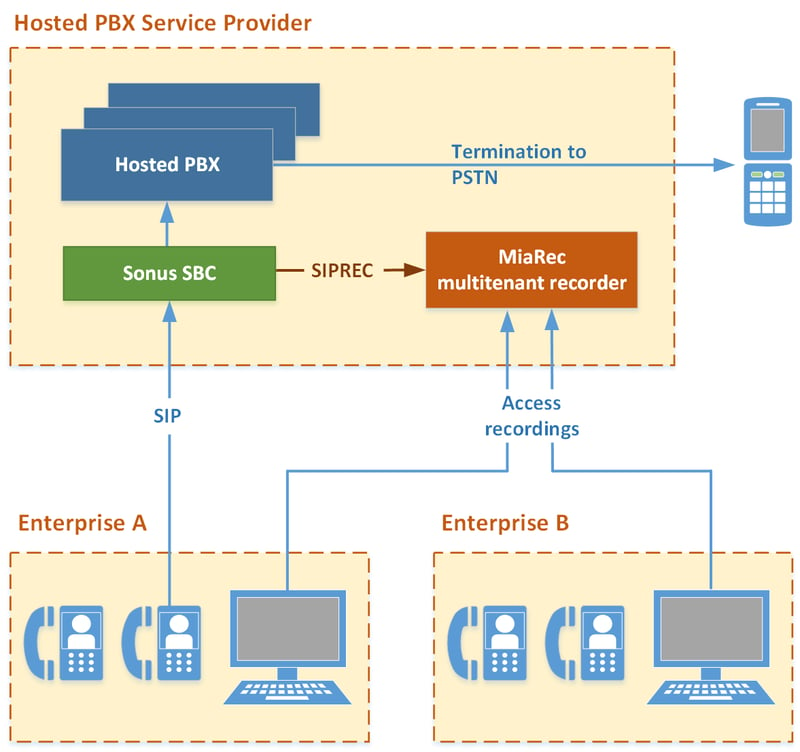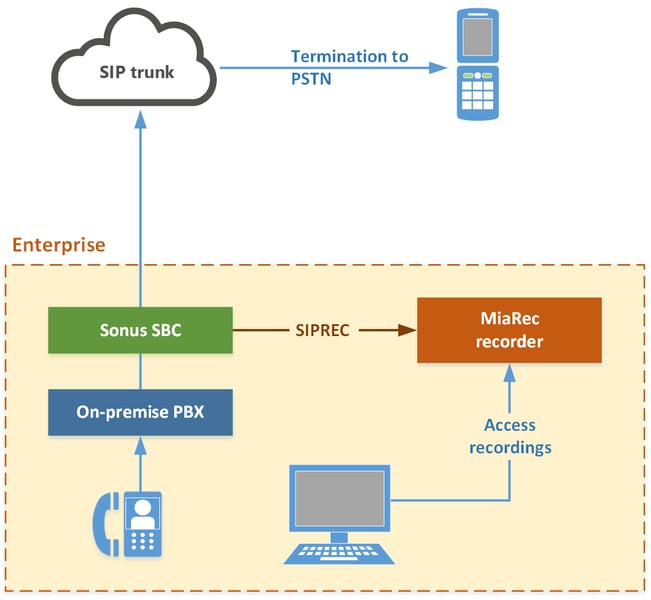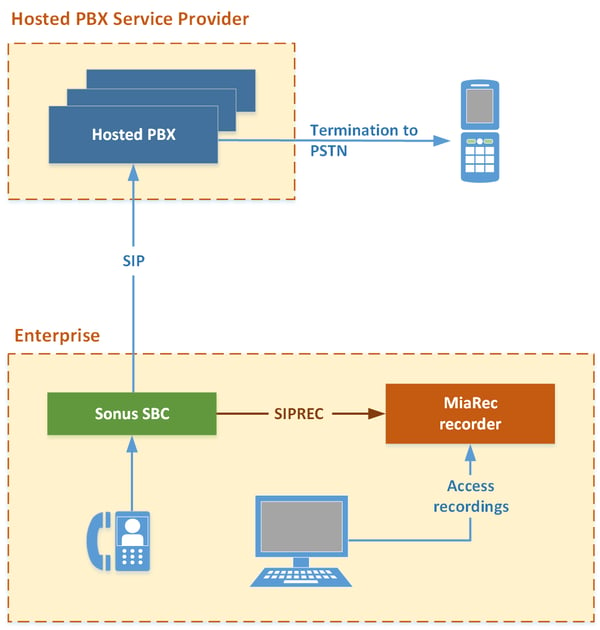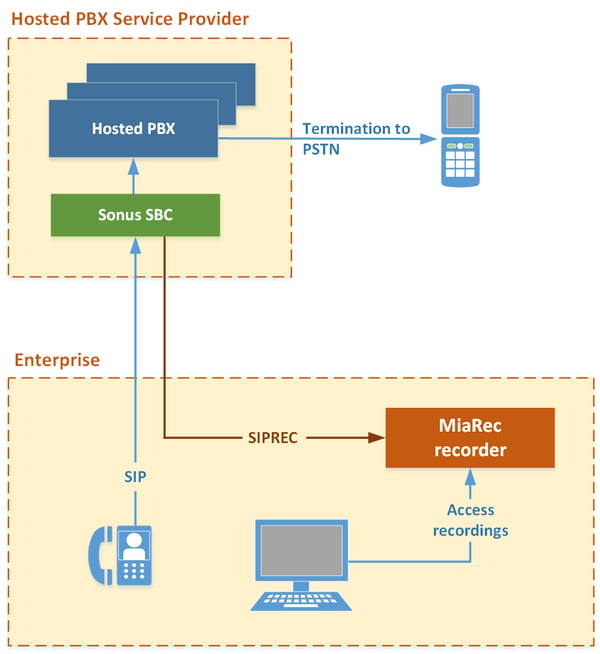Multi-Tenant SIPREC Call Recording Solutions For Sonus SBC
Please note: this is legacy documentation. Please check out https://docs.miarec.com/all/ for the most up-to-date documentation and user guides.

MiaRec is a call recording solution for service providers and enterprises, using Sonus Session Border Controllers (SBC). The multi-tenant architecture of MiaRec solution allows service providers to quickly deploy and offer the profitable mission-critical call recording functionality as a part of their service offering.
MiaRec integrates with the Sonus SBC using the SIPREC interface, allowing to record up to 1,000 concurrent calls per server and providing multiple recording options, i.e. 100% call recording, on-demand, and selective call recording modes.
Service Providers using the Sonus SBC can benefit from a fully functional, reliable, and advanced call recording solution at competitive pricing and low total cost of ownership.
Supported models of Sonus SBC
- Sonus SBC 5000
- Sonus SBC 7000
Deployment models
- Service provider-premises multi-tenant hosted call recording
- Enterprise premises-based call recording
Service Provider Premises
The MiaRec multi-tenant call recording solution may be deployed within the Service Provider's network to provide hosted recording services to enterprise customers.
How it works
The MiaRec solution integrates with Sonus SBC using the SIPREC interface. The Sonus SBC sends the target SIP and media streams toward the MiaRec recording server using SIPREC protocol. Administrators may use SIP recording profiles to define which sessions to record, based on the originating and terminating session characteristics.
The multi-tenant architecture of MiaRec allows hosting multiple customers on a single platform. This significantly reduces per-customer costs in comparison to multi-instance architecture (a dedicated VM per customer).
The end users may access call recording using the web interface. Customer data is securely isolated from each other.

Benefits for customers
The cost to deploy a premise-based recording system can be high, involving a large capital investment, and is typically out of reach for many small enterprises. The software is managed by Service Provider and provided using the Software-as-a-Service (SaaS) model.
-
No upfront investments
-
Customers pay a monthly fee
-
No hardware/software to manage on the customer side
-
Seamless support of distributed multi-site environments and remote workers
Benefits for Service Provider
A hosted call recording service can be a high revenue-generating opportunity for the service providers, enabling the service providers to offer a valuable service to attract and retain high-value customers.
- Attract new customers and grow customer base
- Grow revenue from call recording service
- Deploy a quickly call recording system with low ongoing maintenance and administration
- Integrate an easily call recording system with a rich set of web service APIs
- Help customers to comply with legal requirements to record calls and store call data
- Provide secure access to call recording data via an intuitive web-based interface
- Manage easily call recording system via a powerful centralized web-based administration interface
- Lower costs with flexible licensing options
On Enterprise Premises
The MiaRec call recording solution could be deployed within the enterprise network. There are a few reasons to choose the on-premise deployment model:
-
Regulatory requirements. Due to internal security policies, governmental, or regulatory compliance standards, some customers choose or must store the recorded data within a local network only. They cannot use a hosted call recording service for compliance reasons. On-premise deployment is the only option for such customers.
-
The service provider is not offering a call recordings service yet. The enterprises may use Sonus SBCs for connecting to the SIP Trunk or Hosted PBX services of the service provider that does not support call recording services at the moment. In this case, the enterprises may deploy the recording system by themselves within the local network.
Benefits for customers
- Full control of the recording system and data. The recording server remains in possession of the customer.
- Easier integration between call recording system and customer applications like CRM, QA, etc.
- Usually more cost-effective for large enterprises
Benefits for Service Provider
- No administration burden for a service provider. A recording server is installed and managed by the customer itself.
How it works
The MiaRec recording solution integrates with Sonus SBC using the SIPREC interface. Such configuration allows capturing all SIP-based communications passing through the SBC.
The following network diagrams describe multiple use cases.
Use case 1. On-premise PBX system connects to SIP Trunk services through Sonus SBC
The Enterprises may use the existing on-premise PBX system with SIP Trunk services from Service Providers. The Sonus SBC is deployed at the network edge to protect the Enterprise network.
MiaRec software utilizes the SIPREC interface on the Sonus SBC to capture call recordings and archive them locally within the Enterprise network.

Use case 2. Enterprise's phones connect to Hosted PBX services through Sonus SBC
The Enterprises may subscribe to Hosted PBX services from the Service Provider. The phones are communicating to the Hosted PBX through the Sonus SBC.
MiaRec software utilizes the SIPREC interface on the Sonus SBC to capture call recordings and archive them locally within the Enterprise network.

Use Case 3. The Sonus SBC is located within the Service Provider network, but the recording server is located on the customer premises.
The service providers using Sonus SBC may choose to stream recording data back to the enterprise network to comply with regulatory or internal requirements. The recording server could be managed by Service Provider's engineers as part of a service bundle, but physically the server and data is located within the enterprise network.

It should be noted, that the configuration displayed in that latest diagram requires additional bandwidth reservation for SIPREC traffic. Normally, the call session consumes in and out bandwidth for RTP streams (one is sent by phone towards Service Provider's SBC and another is sent back towards to enterprise network). When the call recording service is activated, the SBC has to send additionally the forked RTP streams back to the enterprise site (two RTP streams per each recorded session). The actual bandwidth usage depends on a number of concurrently recorded sessions and the codec negotiated by parties. For example, 10 concurrently recorded sessions in G.729 codec would require approximately 520 kbps bandwidth. The same amount of concurrent sessions in G.711 codec would require 1.6 Mbps bandwidth.